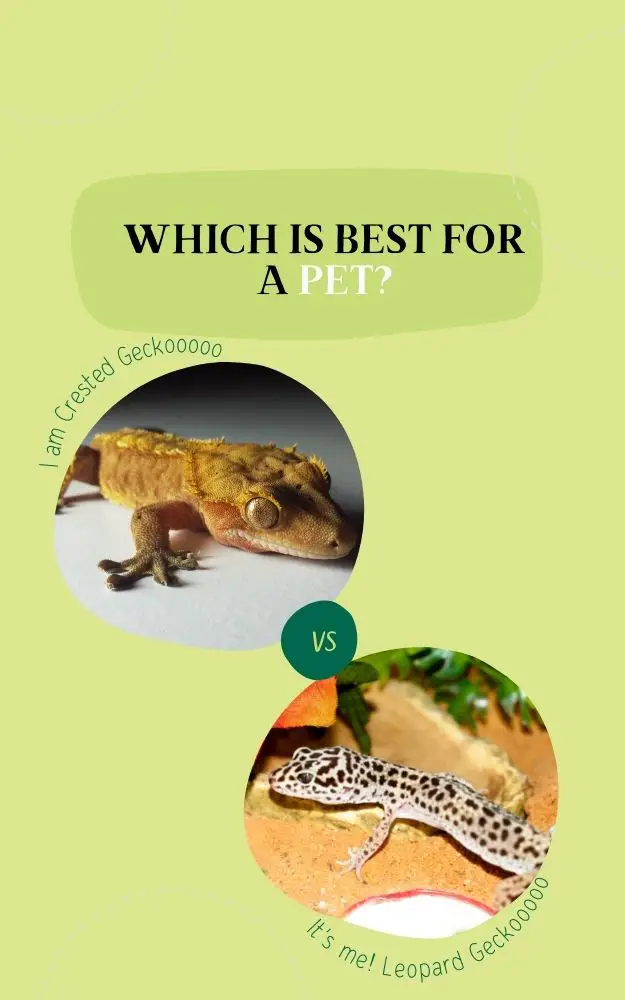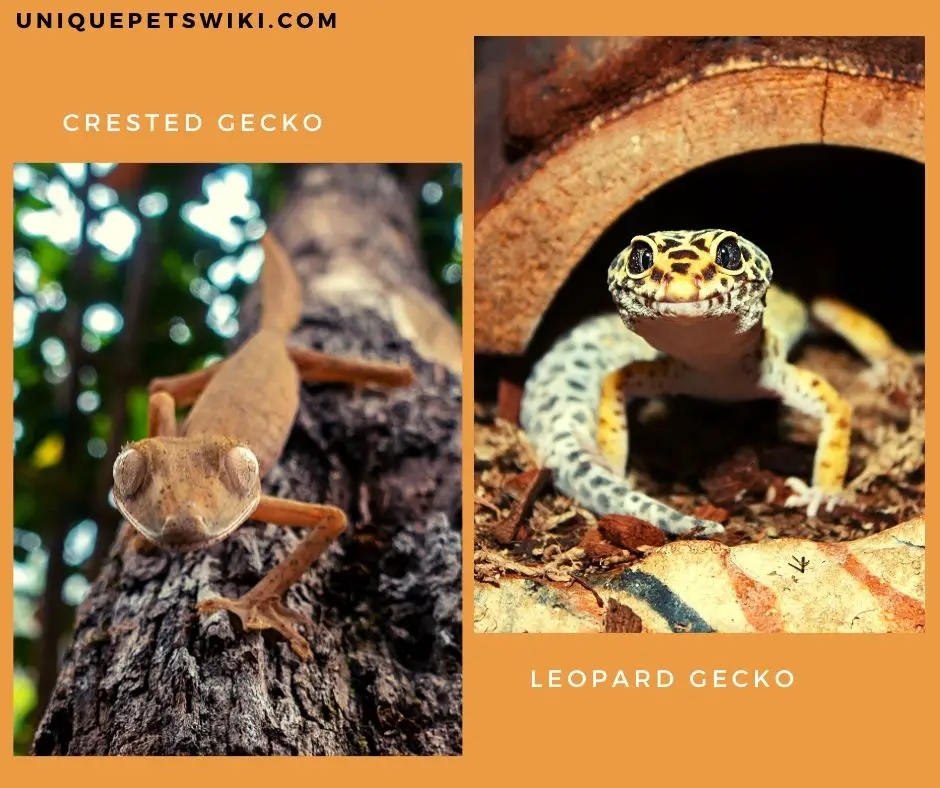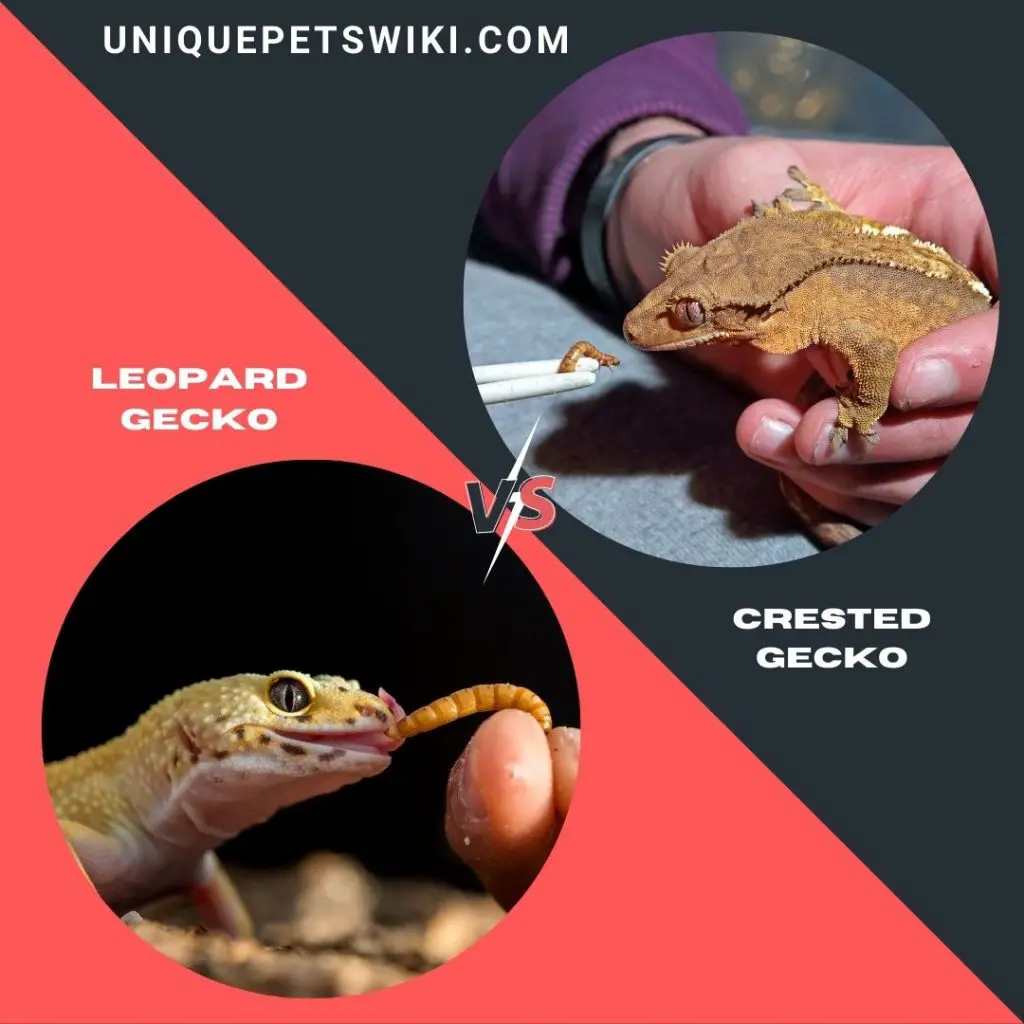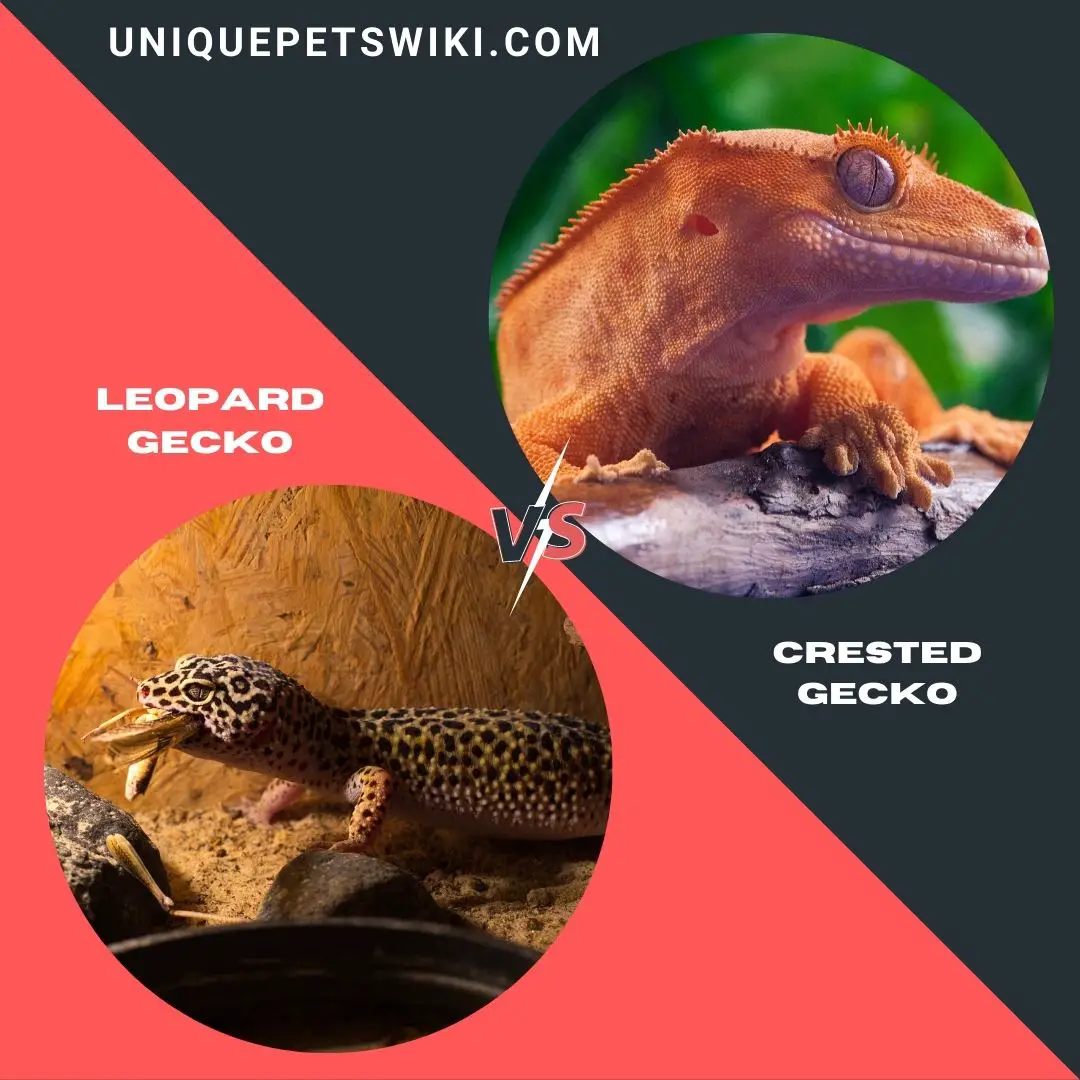Reptiles are creatures that you can keep as a pet if you are looking for a unique experience. You can start your experience by keeping geckos as a pet. There is a wide range of gecko species available as pets, and they have different temperaments and characteristics.
As a beginner, two of the low-maintenance reptiles you can keep as a pet are leopard and crested geckos. Both of them have docile temperaments, and they have a long lifespan. They are also cute and are popular among reptile lovers.
Although crested geckos and leopard geckos have some similarities, they are also different from each other. In this article, we will help compare crested geckos and leopard geckos to help determine which one is best for you.
Contents
Crested Gecko Vs Leopard Gecko: Full Comparison
Leopard geckos and crested geckos are perfect lizard species for beginner hobbyists. They both have docile temperaments, and caring for them is quite easy. However, leopard geckos and crested geckos also have several differences.
Some of the similarities and differences between crested gecko and leopard gecko are stated below.
Physical Description About Species
Crested geckos are cute little lizards and look like a dragon from fairy tale movies. You can easily identify them by their stunning crests with small spikes on their body. Crested geckos also have eyelashes but don’t have eyelids.
They usually have a pale orange eye which complements their sunset-yellow body coloration. Crested geckos also have a thick toe with sticky toe pads, which helps them climb the wall.
On the other hand, leopard geckos have smaller heads and have stunning eyes with eyelids. You can easily identify leopard geckos by the dark brown spots on their body which look like the leopard with their thick tails. They also have a yellow to tan body with white bellies.
Unlike most gecko species, leopard geckos do not have sticky toe pads and are terrestrial lizards.

Size, Weight, And Lifespan
Crested geckos are small-sized lizards. Hatchling crested geckos are usually 3-4 inches long, while adult cresties are around 7-9 inches and can weigh around 55-56g. Crested geckos can live for about 10-15 years in captivity under optimal care.
Leopard geckos are also small-sized lizards. Hatchling leos are usually about 3-3.5 inches long, while adult leopard geckos can grow to about 7-10 inches and can weigh 45-100g. They are usually heavier than crested geckos, and they can store fat in their tails.
Leopard geckos can live for about 10-20 years under optimal care.
Habitat
Crested geckos originate from the southern part of New Caledonia. They are considered arboreal geckos, and they are commonly found on the upper canopy of trees in the rainforest environment.
Since they are tree-dwellers, you will need to create a complicated terrarium setup for them. Their enclosure needs to have lots of vertical space with branches that they can climb. They also need live vegetation in their habitats where they can hide and use as cover.
On the other hand, Leopard geckos originate from the arid desert regions of Iran, Afghanistan, Nepal, Pakistan, and India. They are terrestrial geckos and are commonly found in the dry, rocky grasslands. They are ground dwellers and don’t need too much vertical space in their enclosure.
Leopard geckos usually spend most of their day inside burrows to escape the heat and don’t do too much climbing.

Active Level
Crested geckos are crepuscular, which means they are active during dawn, twilight, and night. However, some hobbyists believe that they are nocturnal as they do most of their activities at night. Once it is dark, you will find crested geckos searching for food and climbing around their enclosure.
Leopard geckos are also crepuscular, and they are active during dawn, night, and twilight. Some hobbyists even believe that their leopard geckos go out at night and while some believe they stay in certain areas and only see them move by dawn or twilight.
Personality And Defense Mechanisms
Generally, crested geckos have a calm and docile temperament. They don’t usually bite and are tolerant of handling. However, if you startle them, they can jump and escape from your hand. Crested geckos can drop their tail when stressed. The bad news is that crested geckos cannot grow back their tail.
Leopard geckos also have a calm and docile temperament. They rarely bite and are more tolerant of handling than crested geckos. Furthermore, leopard geckos can also drop their tail when startled or stressed.
However, you don’t have to worry about this because leopard geckos will regrow their tail.
Diet
Crested geckos are omnivorous reptiles and can eat both fruits and insects. You can feed your cresties with crickets, roaches, etc., but many owners prefer to use a manufactured complete powder diet for them. Although crested geckos can eat fruits, it is best to avoid this because it can leave your gecko with unbalanced nutrients.
On the other hand, leopard geckos are insectivorous reptiles that eat only insects. They prefer live insects as they love hunting for their food. You can feed them with a wide range of live insect food like crickets, roaches, worms, etc.
Furthermore, you will need to gut load and dust their feeder insect with multivitamins, calcium, and mineral supplements before you offer them to your gecko.

Breeding
Crested geckos are prolific breeders. The breeding of crested geckos is so easy that even novice reptile hobbyists can breed them. All you have to do is place a breeding female with a mature male in the same enclosure. Your crested gecko is going to copulate within a few hours to a day after keeping them together.
The natural breeding cycle of crested geckos starts in the spring and will continue through fall. During mating, the male will bite the female head crests while mounting her. Female crested geckos can then lay a clutch of two eggs every 30 days during the breeding season.
Leopard geckos are also prolific breeders. Breeding them is also easy, and you just have to place a mature male and female together. The males are usually aggressive to the female during mating, and you should be ready to remove the female if it is injured.
You can then wait until her wounds heal before you try the reintroduction. Female leopard geckos can lay 8-10 eggs for their first breeding year. However, the number of eggs they can lay can increase as they become more mature.
Although leopard geckos can breed at any time of the year, their normal breeding cycle is from January to September.
Enclosure Size
Crested geckos are small-sized lizards, and you can easily keep them in a 10-gallon vivarium. However, it is recommended that you use a 20-30 gallons vivarium per crested gecko. Furthermore, cresties are arboreal animals, and you will need to provide a vertical tank suitable for climbing for them.
Adult crested geckos can be kept in as big as you want terrarium based on your finances.
Leopard geckos are small-sized reptiles, and you can also keep them in a 10-gallon vivarium. Many hobbyists recommend that you house your leos in a 20 gallons tank to help create a stimulating environment.
Unlike crested geckos, leopard geckos are terrestrial lizards and will need a wide but short tank. You can keep an adult leopard gecko in a 30 gallons tank.
Lighting, Heating, Humidity Requirements
Crested geckos are crepuscular reptiles and don’t really need special UVB lighting in their enclosure. But you can still provide a low UVB lamp in their tank. All you need is to ensure there is an optimal temperature in their enclosure.
The temperature in your crested gecko enclosure should be between 71-79F in the hot spot and during the day. You can maintain optimal temperatures by using low heat fluorescent or just keep stable room temperatures.
Crested geckos also need high humidity in their tank (between 65-68%). This means you will need to mist their tank once or twice a day. You can also use a reptile fogger if your house is very dry.
Leopard geckos are also crepuscular reptiles and do not need special UVB lighting. You can still use a low UVB lamp for Vit. D3 production and if there are live plants in their tank. Leos requires a high temperature and can be between 83-90F in the hot spot during the day.
Last update on 2022-12-29 / Affiliate links / Images from Amazon Product Advertising API
You can maintain the temperature in their tank using bulbs and an under-tank heat mat connected to a thermostat. Leopard geckos need a low humidity level (between 25-40%) in their tank. But you will need to provide them with a shedding box with high humidity levels for their shedding process.
Suitability: Best For Whom?
Both crested geckos and leopard geckos are suitable for beginners. However, crested geckos are perfect if you want to learn more about caring for reptiles. You can use them to learn about the temperature, humidity requirements, and lighting that more sensitive reptiles need.
Furthermore, the crested gecko is suitable for hobbyists who do not want to feed their gecko with live insects.
Leopard geckos are suitable for beginners that do not have any knowledge about keeping a reptile. This is because they are one of the low-maintenance and easiest reptiles that you can care for. Leopard geckos are strictly insectivorous animals and suitable for keepers ready to feed their gecko with live insects.
Costs
Generally, crested geckos and leopard geckos are of the same price. You can buy a regular morph of crested and leopard geckos from reputable breeders for around $40-$60. However, you can get a rare morph of leopard gecko for around $1000-$3000.
A rare morph of crested gecko can cost you over $1000.
Ability To Keep In Groups
Both crested geckos and leopard geckos are solitary creatures. In the wild, they usually live alone except during the breeding season. The males are usually territorial and can be aggressive towards other males.
However, you can also keep them in pairs or small groups, but you will need a large enclosure for that. You can keep 2-3 females together, provided they are of the same size. You can also keep a male with multiple females in a tank.
You should avoid keeping multiple male geckos together in an enclosure as they may fight for territory.
Can You Keep Crested Geckos And Leopard Geckos Together?
It is not recommended to house crested geckos and leopard geckos together. This is because they originate from different regions and they have different temperature and humidity needs. Furthermore, you can easily hurt both geckos by trying to create a balance in their enclosure.
Keeping crested geckos and leopard geckos together can also be stressful to both geckos because they will not be happy and healthy. Furthermore, there is a risk that leopard geckos will fight and bite the crested gecko.
Another thing is that crested geckos have a thin skin and can easily be injured fighting with leopard geckos.
Wrapping Up
Both crested geckos and leopard geckos are hardy creatures which makes them suitable for beginner hobbyists. They also have docile temperament, quite friendly, and caring for them is quite easy. Another thing is that they are available in several morphs and are crepuscular lizards.
The major difference between them is that crested geckos are arboreal lizards while leopard geckos are terrestrial lizards. This means you will need to house crested geckos in a taller enclosure while leopard geckos need more horizontal space in their enclosure.


